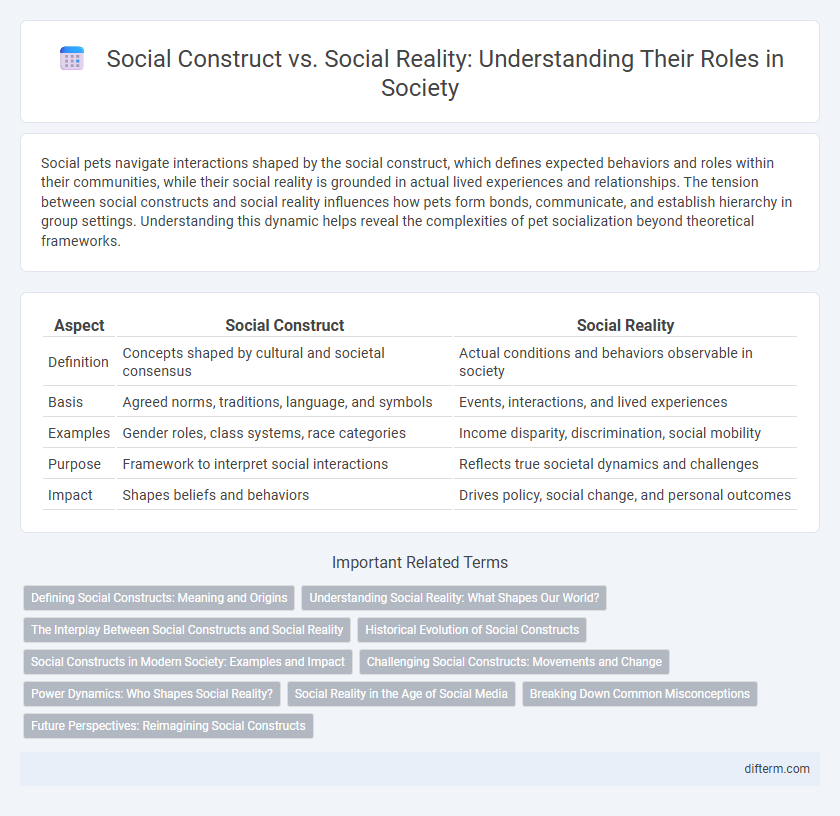Social pets navigate interactions shaped by the social construct, which defines expected behaviors and roles within their communities, while their social reality is grounded in actual lived experiences and relationships. The tension between social constructs and social reality influences how pets form bonds, communicate, and establish hierarchy in group settings. Understanding this dynamic helps reveal the complexities of pet socialization beyond theoretical frameworks.
Table of Comparison
| Aspect | Social Construct | Social Reality |
|---|---|---|
| Definition | Concepts shaped by cultural and societal consensus | Actual conditions and behaviors observable in society |
| Basis | Agreed norms, traditions, language, and symbols | Events, interactions, and lived experiences |
| Examples | Gender roles, class systems, race categories | Income disparity, discrimination, social mobility |
| Purpose | Framework to interpret social interactions | Reflects true societal dynamics and challenges |
| Impact | Shapes beliefs and behaviors | Drives policy, social change, and personal outcomes |
Defining Social Constructs: Meaning and Origins
Social constructs are ideas or perceptions developed and agreed upon by members of a society, shaping behaviors and expectations without inherent natural existence. Originating from collective human interaction, these constructs influence cultural norms, identities, and institutions by providing shared meanings that organize social life. Understanding the distinction between social constructs and social reality is crucial for analyzing how societal norms are established and maintained.
Understanding Social Reality: What Shapes Our World?
Social reality is shaped by collective beliefs, cultural norms, and shared meanings that individuals construct through interaction and communication. These social constructs, such as race, gender, and class, gain significance because societies agree upon their relevance and implications. Understanding social reality requires recognizing how these constructs influence behavior, social roles, and institutional frameworks, thereby shaping our perceptions and experiences of the world.
The Interplay Between Social Constructs and Social Reality
Social constructs such as race, gender, and class shape perceptions and behaviors within societies, influencing social reality by framing individual and collective experiences. These constructs are maintained and altered through cultural norms, language, and institutional practices, which in turn reinforce or challenge existing social structures. Understanding the dynamic interplay between social constructs and social reality is essential for addressing inequalities and fostering social change.
Historical Evolution of Social Constructs
Social constructs such as race, gender, and class have evolved significantly throughout history, shaped by cultural, political, and economic forces rather than inherent natural traits. Historical events like the Industrial Revolution and colonialism played crucial roles in redefining social hierarchies and identity categories. These constructs influence social reality by determining power dynamics and access to resources within societies.
Social Constructs in Modern Society: Examples and Impact
Social constructs such as gender roles, race, and class shape interactions and perceptions in modern society, influencing access to resources and power dynamics. These constructs are maintained through cultural norms, language, and institutional practices, despite lacking inherent biological or natural basis. Understanding their impact reveals how social inequalities are perpetuated and provides pathways for challenging and transforming societal structures.
Challenging Social Constructs: Movements and Change
Movements challenging social constructs such as gender roles, race, and class have reshaped societal norms and power dynamics by exposing the flexibility and arbitrariness of these constructs. Activism and advocacy groups employ critical theory and lived experiences to dismantle ingrained biases, promoting equity and inclusion. The dynamic interplay between social constructs and social reality underscores how collective action can drive transformative social change.
Power Dynamics: Who Shapes Social Reality?
Power dynamics play a crucial role in shaping social reality, with dominant groups and institutions influencing norms, values, and perceptions to maintain control. Social constructs such as race, gender, and class are often manipulated by those in power to legitimize unequal hierarchies and perpetuate systemic inequalities. Understanding who shapes social reality reveals the interplay between authority, ideology, and collective beliefs that define societies.
Social Reality in the Age of Social Media
Social reality in the age of social media is shaped by user-generated content, algorithms, and digital interactions that blur the line between perception and objective truth. Platforms like Facebook, Twitter, and Instagram amplify selective narratives, creating echo chambers that reinforce individual beliefs while shaping collective understanding. This evolving digital environment transforms traditional social constructs into fluid, dynamic experiences influenced heavily by virtual validation and networked communication.
Breaking Down Common Misconceptions
Social constructs like race and gender are often mistaken for inherent social realities, but they originate from collective human agreements rather than objective truths. Misunderstanding this distinction leads to perpetuating stereotypes and systemic inequalities that are socially maintained rather than naturally occurring. Recognizing social constructs enables critical examination and transformation of societal norms toward greater equity and inclusion.
Future Perspectives: Reimagining Social Constructs
Future perspectives on social constructs emphasize the dynamic interplay between evolving cultural norms and technological advancements reshaping social reality. Emerging trends in virtual communities and AI-driven interactions challenge traditional boundaries, prompting a reimagination of identity, belonging, and societal roles. Understanding these shifts enables a proactive approach to creating inclusive, adaptable social frameworks that reflect collective aspirations and diverse experiences.
social construct vs social reality Infographic

 difterm.com
difterm.com